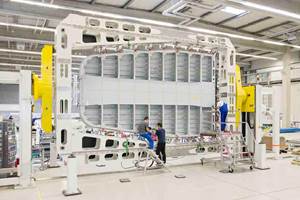Part design criteria
Designers of composite parts can choose from a wide variety of fiber reinforcements and resin systems. Knowledge of material properties is a prerequisite to satisfactory product design, but cost is a major factor, as well. Over-designed composites cannot compete with lower-cost, established material systems. The
Designers of composite parts can choose from a wide variety of fiber reinforcements and resin systems. Knowledge of material properties is a prerequisite to satisfactory product design, but cost is a major factor, as well. Over-designed composites cannot compete with lower-cost, established material systems. The well-designed part not only employs the right materials and processes to meet application requirements, but, many times, is commercially competitive with other materials, when installation, maintenance and lifecycle costs are factored into the equation.
As noted above, fiber reinforcements provide mechanical properties, such as stiffness and strength, and resin matrices provide physical characteristics, including toughness and resistance to impact, weather, fire, UV light and corrosive chemicals.
A significant design consideration is fiber-to-matrix ratio, which is a determining factor in the ultimate weight and cost of the component and governs the extent to which performance properties inherent in the fiber reinforcement can be optimized in the part. Fiber-to-resin ratio can range from 20:80 for low-cost, nonstructural components to as high as 70:30 in some high-end pultrusion applications for structural use. A 60:40 or higher ratio is common in advanced composites.
Three additional factors must be considered when designing with fiber: fiber type, form and orientation or architecture. Orientation refers to fiber direction in relation to the longest part dimension. Typically, fiber architecture is tailored in the direction of the primary loads placed on a structure, a design principle comparable to what civil engineers use to orient steel reinforcing bars in a concrete structure. Common orientations are parallel (longitudinal or 0°), circumferential (90°) and helical (usually ±33° to ±45°). However, fiber direction can vary greatly. For example, a 54° winding angle satisfies both the circumferential (hoop) and longitudinal (axial) strength requirements of most pipes and pressure vessels, usually manufactured by the filament winding process. However, if more stress is placed on the pipe in the axial direction, as is the case with an unsupported span, a ±20°/±70° fiber orientation will provide a stiffer bending modulus for increased axial strength.
Composites, by nature, allow designers to tailor fiber architecture to match the performance requirements for a specific part. Laminates may be designed to be isotropic or anisotropic, balanced or unbalanced, symmetrical or asymmetrical - depending on the in-use forces a component must withstand (see "Glossary of Terms,"p. 47). Varied fiber orientation allows a range of wall-thickness variations, making it possible to develop lightweight, complex shapes and to produce large parts with integral reinforcing members.
An understanding of layered or laminated structural behavior is vital to effective composite component design. Adhesion between laminate layers (called plies) is critical; poor adhesion can result in delamination under stress, strain, impact and load conditions. Ply layup designers must consider mechanical stresses/loads, adhesion, weight, stiffness, operating temperature and toughness requirements, as well as variables such as electromagnetic transparency and radiation resistance. Additionally, composite component design must encompass surface finish, fatigue life, overall part configuration, and scrap or rework potential, to name just a few of the many applicable factors.
The intended fabrication method also will influence design. For instance, manufacturers of filament-wound or tape-layed structures use different reinforcement forms and build-up patterns than those used either for laminate panels layed up by hand or for vacuum-bag-cured prepreg parts.Resin transfer molding (RTM) accommodates three-dimensional preforms more easily than do some other manufacturing techniques. The varying benefits and limitations of these fabrication techniques provide designers a very flexible set of options, in their efforts to achieve optimum performance and economies.
A common type of composite structure - sandwich construction - combines a lightweight core material with laminated composite skins (facesheets), similar to the construction of corrugated cardboard. These very lightweight panels have the highest stiffness-to-weight and strength-to-weight performance of all composite structures and are extremely resistant to bending and buckling. Suitable core materials include closed-cell foams, balsa wood and celled honeycomb in a variety of forms (aluminum, paper or plastic). Some foam cores are syntactic (i.e., containing hollow microspheres) for even lighter weight. Sandwich construction is used extensively on modern aircraft and boats as well as in applications such as cargo containers and modular buildings.
Related Content
Clean Sky 2 outer wing box demonstrator validates OOA LRI, shimless assembly and SHM
Full-scale wing box project achieves TRL 5 with 2% weight reduction and 4% reduction in recurring production costs through improved manufacturing efficiency and assembly processes.
Read MoreBladder-assisted compression molding derivative produces complex, autoclave-quality automotive parts
HP Composites’ AirPower technology enables high-rate CFRP roof production with 50% energy savings for the Maserati MC20.
Read MoreFrom the CW Archives: Airbus A400M cargo door
The inaugural CW From the Archives revisits Sara Black’s 2007 story on out-of-autoclave infusion used to fabricate the massive composite upper cargo door for the Airbus A400M military airlifter.
Read MoreCOMPINNOV TP2 project promotes use of thermoplastics in aerospace
Completed in 2023, COMPINNOV TP2 explored thermoplastic composites, enhancing the understanding between prepregs and production methods to foster the potential for French aerospace innovation.
Read MoreRead Next
All-recycled, needle-punched nonwoven CFRP slashes carbon footprint of Formula 2 seat
Dallara and Tenowo collaborate to produce a race-ready Formula 2 seat using recycled carbon fiber, reducing CO2 emissions by 97.5% compared to virgin materials.
Read MoreVIDEO: High-volume processing for fiberglass components
Cannon Ergos, a company specializing in high-ton presses and equipment for composites fabrication and plastics processing, displayed automotive and industrial components at CAMX 2024.
Read MoreComposites end markets: New space (2025)
Composite materials — with their unmatched strength-to-weight ratio, durability in extreme environments and design versatility — are at the heart of innovations in satellites, propulsion systems and lunar exploration vehicles, propelling the space economy toward a $1.8 trillion future.
Read More











